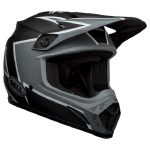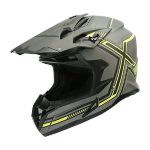Strapping your motorcycle helmet correctly is a crucial aspect of rider safety. A poorly fastened helmet can compromise its protective capabilities in the event of an accident. This guide will walk you through the step-by-step process of ensuring your helmet is securely fastened, providing you with the confidence and peace of mind to enjoy your rides to the fullest.
Understanding Motorcycle Helmet Straps and Buckles
Before diving into the strapping process, it’s essential to familiarize yourself with the different types of helmet straps and buckles available.
Common Helmet Strap Types:
- Double D-ring: Considered the gold standard for safety, this system involves two metal rings that are linked to one of the straps.
- Quick-release buckle: This type of buckle offers convenience with a push-button mechanism.
- Snap-on buckle: Similar to a seatbelt buckle, it’s relatively easy to use but might not be as secure as other options.
Proper Helmet Fit:
- Ensure the helmet fits snugly but comfortably on your head.
- The helmet should sit level on your head, not tilted forward or backward.
- The cheek pads should provide a snug fit without causing discomfort.
How to Strap a Double D-Ring Helmet
The double D-ring system is known for its exceptional security. Here’s how to strap it correctly:

- Insert the chin strap: Pass the chin strap through both D-rings.
- Tighten the strap: Pull the long strap to tighten the chin strap. Ensure it’s snug but not overly tight.
- Secure the excess strap: Most helmets have a snap button to hold the excess strap in place.
How to Strap a Quick-Release Buckle Helmet
Quick-release buckles offer convenience, but it’s crucial to ensure proper usage:
- Insert the chin strap: Pass the chin strap through the buckle.
- Engage the buckle: Press and hold the release button while pushing the chin strap into the buckle.
- Tighten the strap: Adjust the strap for a snug fit.
How to Strap a Snap-On Buckle Motorcycle Helmet
While not as secure as other options, the snap-on buckle is still effective when used correctly:
- Insert the chin strap: Pass the chin strap through the buckle.
- Snap the buckle: Push the two buckle parts together until they securely snap into place.
- Tighten the strap: Adjust the strap for a comfortable and snug fit.
Tips for a Secure Fit
- Check the fit regularly: Ensure the helmet continues to fit properly as your head shape changes.
- Replace worn-out straps: Damaged straps can compromise safety.
- Practice strapping and unstrapping: Familiarize yourself with the process to save precious seconds in an emergency.
- Consider a helmet retention system: Some helmets offer additional straps to prevent the helmet from coming off in an accident.
Common Mistakes and How to Avoid Them
- Loose chin strap: A loose chin strap can allow the helmet to come off in an accident.
- Incorrect alignment: Ensure the helmet sits level on your head for optimal protection.
- Overtightening: While a snug fit is essential, an overly tight strap can cause discomfort and fatigue.
The Importance of Motorcycle Helmet Maintenance
Regular helmet maintenance is crucial for ensuring its safety and longevity.
- Clean the helmet regularly: Use mild soap and water to remove dirt and grime.
- Inspect the helmet for damage: Check for cracks, scratches, or other signs of wear and tear.
- Store the helmet properly: Avoid exposing the helmet to extreme temperatures or direct sunlight.
Choosing the Right Motorcycle Helmet
Selecting the perfect motorcycle helmet is as crucial as strapping it correctly. A well-chosen helmet not only protects your head but also enhances your riding experience. Let’s delve into the factors to consider when selecting the right helmet for you.
Understanding Motorcycle Helmet Types
Motorcycle helmets come in various types, each designed for specific riding conditions and preferences.

- Full-face helmets: Offering maximum protection, these helmets cover your entire head, including the chin. Ideal for sport bikes and touring.
- Modular helmets: Combining the features of full-face and open-face helmets, they allow you to flip up the chin bar. Versatile for various riding styles.
- Open-face helmets: Providing good visibility, these helmets cover the top of your head but expose your face. Suitable for cruising and urban riding.
- Dual-sport helmets: Designed for off-road and street riding, these helmets feature a beak-like visor for off-road conditions and a removable peak for street use.
- Off-road helmets: Built for rough terrain, these helmets offer maximum ventilation and protection against impacts.
Key Factors to Consider
- Helmet Fit: The most critical factor is a proper fit. A helmet that’s too loose or too tight can compromise safety. Try on different sizes and styles to find the perfect match.
- Helmet Size: Measure your head circumference to determine the correct size. Most helmet manufacturers provide sizing charts.
- Helmet Shape: Head shapes vary, so consider whether you have a round, oval, or intermediate oval head. Some helmet manufacturers cater to specific head shapes.
- Ventilation: Adequate ventilation is essential for comfort, especially during warmer rides. Look for helmets with adjustable vents to regulate airflow.
- Visor: The visor should provide clear visibility and protection from the elements. Consider options with anti-fog and scratch-resistant coatings.
- Noise Reduction: A quiet helmet can significantly enhance your riding experience. Some helmets incorporate noise-reducing technologies.
- Weight: A lighter helmet can reduce neck strain during long rides. However, weight should not compromise safety.
- Certifications: Ensure your helmet meets the necessary safety standards, such as DOT (Department of Transportation) in the United States or ECE (Economic Commission for Europe) in Europe.
Additional Features to Consider
- Communication systems: Integrated communication systems allow you to stay connected while riding.
- Drop-down sun visor: A built-in sun visor offers convenience and eliminates the need for sunglasses.
- Emergency release system: Some helmets feature emergency release systems for quick removal in case of an accident.
- Interior comfort: Look for removable and washable liner materials for hygiene and comfort.
Maintaining Your Motorcycle helmet
Proper helmet care is essential for its longevity and performance.
- Clean regularly: Use mild soap and water to clean the exterior and interior of the helmet.
- Avoid harsh chemicals: Harsh chemicals can damage the helmet’s materials.
- Inspect for damage: Regularly check the helmet for cracks, scratches, or other signs of wear and tear.
- Store properly: Store your helmet in a cool, dry place away from direct sunlight.
By carefully considering these factors, you can choose a motorcycle helmet that provides optimal protection, comfort, and style for your riding adventures.
Common Motorcycle Helmet Myths Debunked
Many misconceptions surround motorcycle helmets, which can lead to unsafe riding practices. Let’s dispel some of the most common myths.

Myth 1: Helmets Cause Head Injuries
Fact: This is entirely false. Helmets are designed to protect your head in the event of an accident. While they cannot prevent all head injuries, they significantly reduce the severity of impact.
Myth 2: Open-Face Helmets Are Safer Than Full-Face Helmets
Fact: Full-face helmets offer superior protection compared to open-face helmets, as they cover your entire head, including your chin and jaw. While open-face helmets may be more comfortable in warmer weather, they provide less protection in case of an accident.
Myth 3: Expensive Helmets Offer No More Protection Than Cheap Helmets
Fact: While all DOT-approved helmets meet basic safety standards, higher-quality helmets often incorporate advanced technologies and materials that enhance protection, comfort, and ventilation.
Myth 4: Helmets Restrict Vision
Fact: Modern helmets are designed with optimal visibility in mind. High-quality visors offer clear vision and protection from the elements.
Myth 5: Helmets Are Uncomfortable
Fact: Helmet technology has advanced significantly, resulting in comfortable and well-ventilated helmets. It’s essential to choose a helmet that fits properly and meets your specific needs.
Myth 6: Helmets Are Only for Beginners
Fact: Helmets are crucial for riders of all experience levels. Accidents can happen to anyone, regardless of riding experience.
Myth 7: You Can Hear Better Without a Helmet
Fact: While helmets can slightly reduce hearing, they protect your ears from wind noise and other harmful sounds, reducing the risk of hearing damage.
Properly strapping your motorcycle helmet is a non-negotiable aspect of rider safety. By following the guidelines outlined in this guide, you can significantly reduce the risk of head injuries in the event of an accident. Remember, a well-fitted and securely fastened helmet is your first line of defense on the road.


